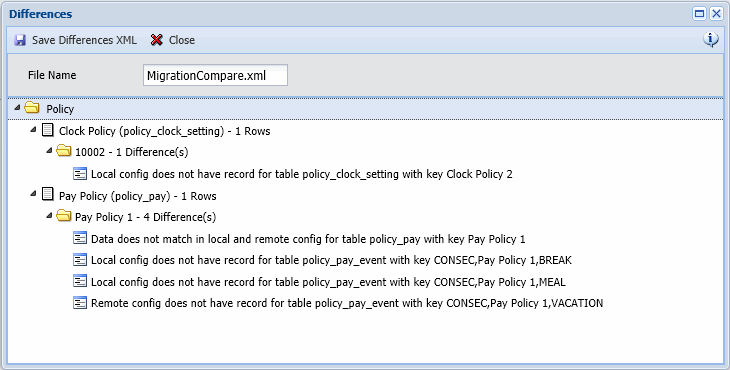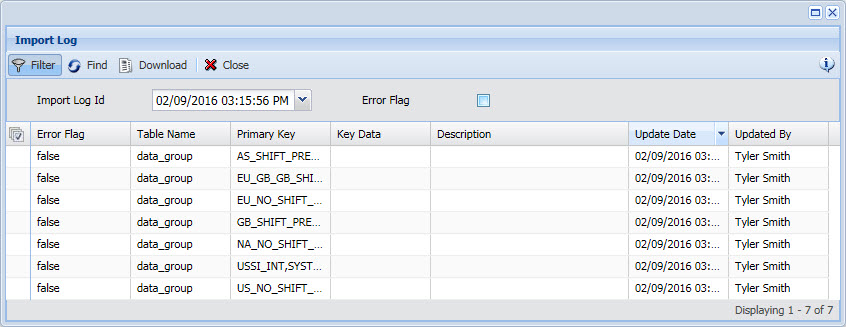Detail Form: Import Log
The Config Import form is used to import configuration data (Calc Rules, Policies, Events, etc.) from an XML file into your database. This XML file is created when you use the Config Export form to export the configuration data from a different database.
For example, your company may initially install and configure the application on a test database. Once testing is complete and all the necessary configuration changes have been made, a production database will be used. The configuration data from the test database is exported to an XML file using the Config Export form. You can then use the Config Import form to import the configuration data to the production database.
The Config Export and Config Import forms are part of the Data Migration feature.
You can only import to a database that has the same schema version as the database that exported the data.
Note that system-defined records (such as the System Default policies and event templates) will only be imported if you check Include System when you create the export file.
See Also:
Config Import Field Descriptions
XML File
Name of the XML file (created on the Config Export form) containing the data you will import. Click Browse to select this file.
Select the type of import you are generating.
Insert: Select this option if you are importing only new records into your database. The system checks to see if a record (with the same start and end date) already exists. If the record does not yet exist, the record will be imported. If the record already exists, it will not be imported and an error will occur for that record.
Update: Select this option if you are updating existing records. The system checks to see if a record with the same start and end date already exists. If the record already exists, the record in the database will be updated. If the record does not exist, it will not be inserted (an error will occur for that record instead).
For example, if you are importing event records in order to update one event in your database, select the Update option when importing the events. The import will only update existing records. If a record you are importing does not exist, it will not be inserted (an error will occur for that record instead).
Insert/Update: Select this option to insert the record if it does not yet exist, or update the record if it already exists. The system checks to see if a record with the same start and end date already exists. If a record with the same start and end date already exists, the system will update it. If a record with the same start and end date does not exist, they system will insert it. If the existing record and the imported record have overlapping start and end dates, the existing record will be deleted and the new record will be imported.
For example, if you are importing a Pay Policy with the same name but different start and end dates as an existing policy, and you select Insert/Update, the existing Pay Policy record will be deleted and the record you are importing will be inserted.
Detail records are imported in Insert/Update mode. When a record is being updated, its detail records will be inserted if they do not yet exist, or updated if they already exist. Likewise, if a detail record does not exist in the import file, it will be deleted from the database.
Data Migration Contexts (folders)
The folders in the middle of the Config Import form represent the various Data Migration Contexts. These contexts are used to group the imported data into categories. For a list of these contexts and the data that is included, see Data Migration Contexts.
Click the ![]() button to expand
a context and view the data types that are included in it. Check the options
you want to import.
button to expand
a context and view the data types that are included in it. Check the options
you want to import.
Use this button to verify that the selected records can be imported to the database. Once you have selected the items in the Data Migration Contexts that you want to import, click Validate. If the selected records can be imported, a Validate Successful message will appear. Otherwise, the Import Log form will open to display any error messages. For example, if a record already exists, an error will display.
Compare
Use the Compare button to compare all or part of the file you are importing with the database. You can save the differences in an XML file that can be imported separately. See “Compare Data Using the Config Import Form” below.
Import
Use this button to import the selected records to the database. Select the items in the Data Migration Contexts that you want to import and click Import. If the selected records were imported, an Import Successful message will appear. Otherwise, the Import Log form will open to display any error messages.
View Log
Click this button to open the Import Log form. Use this form to check the status of the various import attempts. See View Log for more information.
Log in to the application that is connected to the database you want to export (e.g., your test database).
Use the Config Export form to create the XML export file.
Log in to the application that is connected to the database where you will import the data (e.g., your production database).
Click Main Menu > Configuration > Migration > Config Import.
Click the Browse button next to the XML File field.
Select the migration file you saved in step 2.
The Data Migration Contexts from the XML file will display in the middle of the form.
Check the contexts you want to compare with your database.
Click the Compare button.
If there are any differences between the file you are importing and the database you are logged into, the Differences pop-up form will appear.

This form will show records that are in the import file but do not exist in the database. The form also shows records in the import file that are different from the records in the database.
If you only want to import these differences, click Save Differences XML. Otherwise, click the Close button when you are done viewing the differences.
If you clicked Save Differences XML, your browser will display a message asking if you want to save the file. Save the file to the location of your choice. You can now import this differences file.
To continue importing data, see “Import Data Using the Config Import Form” below.
Log in to the application that is connected to the database you want to export (e.g., your test database).
Use the Config Export form to create the XML export file.
Log in to the application that is connected to the database where you will import the data (e.g., your production database).
Click Main Menu > Configuration > Migration > Config Import.
Click the Browse button next to the XML File field.
Select the migration file you saved in step 2, or select a differences file (see “Compare Data Using the Config Import Form” above).
The Data Migration Contexts from the XML file will display in the middle of the form.
Check the contexts you want
to import. To select individual items in a context, click the ![]() button to expand a context
folder and check the items you want to import.
button to expand a context
folder and check the items you want to import.
Select the Import Type for the data you are importing.
Select Insert if you are importing only new records into your database. Select Update if you are updating existing records. Select Insert/Update to insert the record if it does not yet exist, or update the record if it already exists.
Detail records are imported in Insert/Update mode. When a record is being updated, its detail records will be inserted if they do not yet exist, or updated if they already exist. Likewise, if a detail record does not exist in the import file, it will be deleted from the database.
To validate the data before attempting to import it, click Validate. If the selected records can be imported, a Validate Successful message will appear. Otherwise, the Import Log form will open to display any error messages. For example, if a record already exists, an error will display. Click the Close button when you are done.
To import the data from the XML file, click Import. If the selected records were imported, an Import Successful message will appear. Otherwise, the Import Log form will open to display any error messages. Click the Close button to close the Import Log form.
Note: If you import rules, you need to use the Sync Rule button on the Calc Rule form to recompile the rules in the new database. The Sync Rule button will make sure the imported rules are in sync with the sequences in the database.
When you click the View Log button on the Config Import form, the Import Log pop-up form appears. You can use this form to check the status of the various import attempts.

Click the ![]() Filter
button to display the filter fields.
Filter
button to display the filter fields.
From the Import Log ID field, select the import that you want to view.
To display only errors associated with the import, check the Error Flag box. If you do not check this box, only successful imports will be displayed.
Click Find to update the import log records in the middle of the form.
Error Flag displays true if the Error Flag box is checked, indicating the records shown are errors. This column displays false if Error Flag is not checked, indicating the records shown were imported successfully.
Table Name displays the name of the table into which the record was imported.
Primary Key is a value used to look up the record in the database.
Key Data identifies the data imported in the record.
Description will display the reason for the error if Error Flag is set to true.
Update Date and Updated By identify the date when the import or error occurred and the person who performed the import.